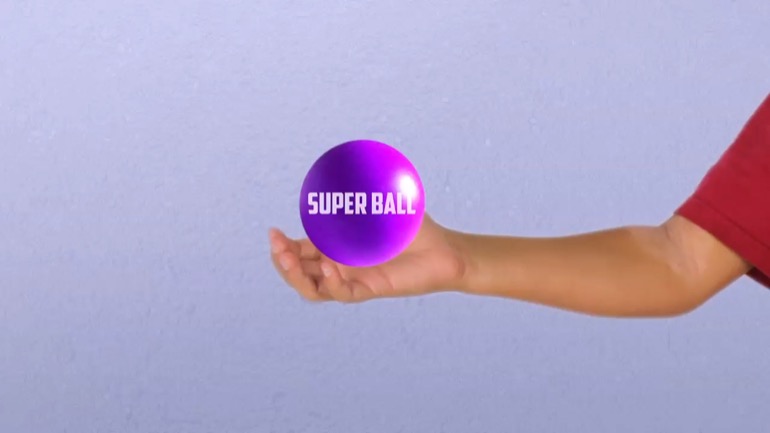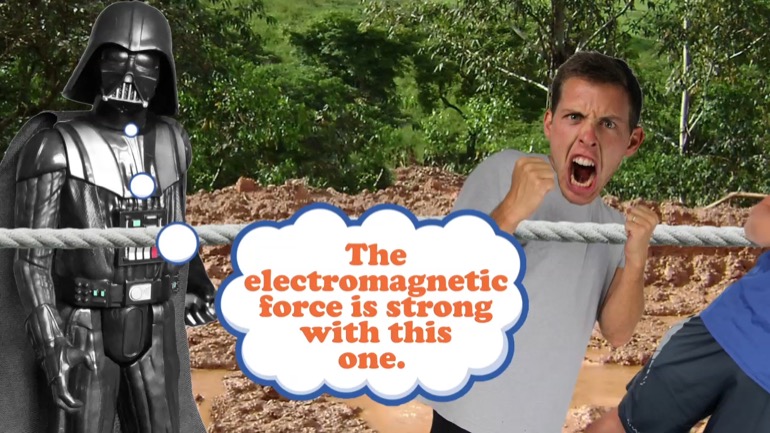ShmoopTube
Where Monty Python meets your 10th grade teacher.
Search Thousands of Shmoop Videos
Physics Videos 34 videos
Isaac Newton. Who was he? Why do we need to know about him? In a physics course, no less? Well, he's only the most famous physicist in history, and...
What are the basics of trigonometry? And why are we learning about this in a physics course? Both good questions. In this video, you'll learn about...
It's time to make our liters and meters work together. Enough of the bickering, right? In this video, we'll do some unit analysis, covering SI Unit...
Physics: Electrical Charge Transfer 20 Views
Share It!
Description:
What is electrical charge transfer? Y'know that shock you get shuffling your feet along the carpet and then touching an electrical socket? Yeah, don't do that.
Transcript
- 00:00
Shmoop! Electrical charge transfer: without it, well this whole internet thing
- 00:07
wouldn't work very well. What is electricity anyway? Well it charges. Electric [facts on chalkboard]
- 00:13
field, strawberry field. Playing with sticky tape, haha we've done that. Well I think it's safe to say that electricity
- 00:23
is important. It's the reason your fridge keeps everything cold. The reason your
- 00:28
microwave heats up your food, and well yeah, it's the reason you're able to
Full Transcript
- 00:31
watch this video right here. Without electricity we'd probably be
- 00:35
broadcasting this physics lesson via, smoke signals. All right well what is
- 00:39
electricity anyway? Don't worry we're not gonna go all the way back to Ben [Ben Franklin flying kite in storm]
- 00:43
Franklin flying a kite in a storm or anything. But, we need to understand
- 00:47
what's actually going on when you plug in your hairdryer. I mean we know that
- 00:51
the end result will be incredible sexiness. But, how does electricity move
- 00:55
from the wall, to that wire, to the actual motor, fan thingy, there. Well let's take a
- 01:00
look at an atom. We'll go super basic, the hydrogen atom. Almost all hydrogen has
- 01:05
one proton and one electron. Well the proton has a positive charge, it's all [hydrogen atom drawing]
- 01:09
about smiles and motivational posters and the electron here is a real debbie
- 01:14
downer, because well it has a negative charge. That positive and negative
- 01:18
difference is called polarity. And the amount of charge in a proton and in an
- 01:22
electron is equal, even though their polarity is opposite. That amount is
- 01:26
called the elementary charge. You can't get any smaller than the elementary
- 01:31
charge and that's as low as it goes. There's never going to be a time when
- 01:34
just half an electron shows up, or where we'll have to deal with one quarter
- 01:38
proton. The elementary charge is written as just a little e, like that.[atom with e above] These
- 01:43
electrical charges either positive or negative are fundamental properties of
- 01:47
matter, kind of like mass. And you might be wondering where does charge really
- 01:51
come from and yeah that's a really good question. I hope you come up with an
- 01:54
answer soon because so far science doesn't have a good explanation. There
- 01:58
are some ideas out there that are pretty complicated and involve mind-bending
- 02:02
aspects of quantum mechanics and honestly, just thinking about that stuff [construction man wearing helmet]
- 02:06
makes me want to find a darkroom and rock gently back and forth. So we're not
- 02:09
gonna dig into that right now. And just like mass charge is conserved,
- 02:13
meaning it can't just disappear. It can move from one object to another,
- 02:17
but, you can't spontaneously create a charge out of thin air.
- 02:21
Now in our hydrogen atom here, we've got one negative particle and one positive
- 02:25
one. Everything is nice and balanced, that's not always case. Some molecules
- 02:30
have more protons than electrons. And well you know vice versa. It's pretty [two atoms working next to each other]
- 02:34
common for electrons to only be loosely attached to the nucleus of an atom. They
- 02:39
don't want to get tied down, so they're playing the field.
- 02:42
Well these electrons can become completely free, just waiting for some
- 02:46
new positively charged atom to come and sweep them off their feet. And it would
- 02:50
have to be a positively charged atom, because like charges repel and opposite
- 02:55
charges attract. It's like magnets, in fact it is magnets.[red magnet]
- 02:59
Electricity and magnetism are closely related. So closely related in fact, that
- 03:03
there's a whole field of study, within physics, called electromagnetism. Magnets
- 03:08
have two poles, one positive and one negative, one north and one south. Maybe
- 03:12
you've tried to push the positive poles of two magnets together and felt a
- 03:15
strong resistance pushing your hands back. It's the whole like charges repel
- 03:20
thing. And of course if you bring the positive side of a magnet, near the
- 03:24
negative side of a different magnet, you're gonna have an instant attraction.[boy and girl holding magnets]
- 03:27
All right you guys get a room. Any particle that has an electric charge,
- 03:30
creates an electric field. An electric fields can be a little bit tricky
- 03:35
because we can't see them. It's a lot easier to do physics with things you can
- 03:38
actually look at. But electromagnetic fields are similar to gravitational
- 03:41
fields. They do their work without requiring any movement from their source.
- 03:45
If I want to make something move, I have to go over and make contact with it. So
- 03:48
if a Girl Scout comes to my front door trying to sell me cookies, I have to make[girl scout at door]
- 03:52
direct contact with the door to slam it in her face. Sorry, but, Thin Mints are
- 03:57
addictive and I don't need to go down that road again. But an electromagnetic
- 04:01
field, can push, or pull, something towards an object, without any contact at all.
- 04:05
We're gonna prove this in just a minute. There's another way gravity and
- 04:08
electricity are similar. They can both create potential energy. Gravitational
- 04:13
potential energy is created when something is lifted off the ground. If I
- 04:17
pick up a hammer, gravitational potential energy is stored, because the Earth's [man holding hammer]
- 04:21
gravitational field is pulling on that hammer. You've learned that the hard way, if
- 04:25
you've ever accidentally dropped a hammer on your toesies. Result? Potential
- 04:29
energy, is converted into kinetic energy. It also results in the chemical
- 04:33
energy in my body, being converted to sound energy, as I scream like a baby.
- 04:38
With electricity, we have both electric potential and electric potential energy.
- 04:43
Yep they're very similar sounding, but no, they're not the same thing.
- 04:46
Electrical potential, is also called electrical potential difference. You can
- 04:51
also call it voltage, which you've probably heard before. Electrical [chalkboard with facts]
- 04:55
potential, is the potential energy that a theoretical charge would have, if placed
- 04:59
in an existing field and it's what causes electricity, to go from point A, to
- 05:04
point B, in a circuit. Electoral potential energy, is potential energy to charge
- 05:08
your concern with, actually possesses. That might sound confusing, but
- 05:12
electrical potential and electoral potential energy, will be the topic of a
- 05:15
future video with equations and all sorts fun stuff. So, you know, don't sweat
- 05:19
it for now. Nope, right now we're gonna go to the
- 05:21
experiment with electricity. Normally I'd recommend leaving electricity to the
- 05:25
professionals, like me. You shouldn't be messing around too much with electrical
- 05:29
stuff. Because well, it doesn't always end well and no one likes the smell of [2 boys in school lab]
- 05:33
burning hair. But in this case all we need is some tape, scotch tape, to be
- 05:36
precise. Yeah there aren't gonna be bolts of electricity flying around, but this is
- 05:40
still gonna be pretty cool. We need four strips of tape, each about five inches
- 05:43
long. That's about 12 centimeters, if you don't speak, you know, American. Fold over
- 05:48
a little bit at one end, so you've got a non sticky handle to work with. Okay now
- 05:52
take two strips of tape. We'll get super creative and call them piece 1 and piece
- 05:55
2. Stick them to your desk, or your table, or countertop, or whatever and pull [2 pieces of tape]
- 05:59
each piece off of your chosen surface and keep them separated. Alright, job calls for
- 06:03
two hands people. Okay now bring the non sticky sides, of each piece of tape,
- 06:08
toward each other. The two pieces should repel each other just like that. Now
- 06:12
bring one of the pieces near your hand, it should be attracted to you and of
- 06:15
course it is. You're a total hottie right. But it's also due to electric charge.
- 06:19
When you stick tape to your desk, it actually forms molecular bonds and when
- 06:24
you pull the tape off those molecular bonds are broken and some electrons come
- 06:28
along for the ride. Yeah, who know that, when you use scotch tape you're actually
- 06:32
splitting up molecules. It's not quite the reaction you get from splitting atoms, and
- 06:37
no that's a good thing. [nuclear bomb going off] Crafting should never go nuclear. All
- 06:40
right well since there are extra electrons, sticking to the tape, well it
- 06:43
now has a negative charge. And since we did the same thing with each piece, they
- 06:47
both have the same kind of charge. Like charges repel, so they don't want
- 06:51
anything to do with each other. But you and your hand? Well turns out your, a ray
- 06:55
of positivity, in this cruel world, so the tape wants to snuggle up with you. [hand attracting tape]
- 07:00
Because opposite charges attract. All right, now let's play with last two
- 07:04
pieces of tape. Keeping with our awesome naming system, we'll call them
- 07:08
3 and 4. Stick piece 3, to the non sticky side a piece 4. Before you pull them
- 07:14
apart, you should know, that we're gonna be doing the same kind of thing. Holding
- 07:17
the pieces close to each other and seeing what happens. All right any
- 07:20
guesses? Will they repel each other, maybe attract each other, or maybe they'll just
- 07:24
chill out and do nothing and this whole experiment will be a bust. Okay let's get
- 07:28
to it. Pull piece three off piece four and hold
- 07:30
them close to each other. Aw, now we've got attraction going on. In this case where [2 pieces of tape connecting]
- 07:35
we had some hot tape, on tape action, piece three snagged some electrons from
- 07:39
piece 4. Which means piece 3 is negatively charged and piece 4 is given
- 07:44
off positive vibrations. Because well it lost electrons, giving it an imbalance of
- 07:49
protons. When we've got opposite charges, we've got attraction. This experiments an
- 07:55
example of static electricity. Static electricity is an imbalance of charges
- 07:59
on the surface of an object. That imbalance can build and build, but [chalkboard with facts]
- 08:02
eventually it will discharge. Alright we've dealt with static electricity
- 08:07
before, ever grabbed a doorknob and felt a jolt? Well unless your parents have grounded
- 08:12
you and wired your doorknob, so you can't leave. What you experienced was static
- 08:16
electricity and static electricity is why you hear a wool sweater crackling on
- 08:21
a dry winter day. We tend to think of static electricity as a small little zap,
- 08:26
but it can get huge. In a thunderstorm there are a whole lot of little pieces[thunder cloud with ice]
- 08:30
of ice moving around in the clouds, bumping into each other and swapping
- 08:33
electrons. This creates an imbalance of charges and when you get a bunch of
- 08:37
positively charged particles at the top of a cloud and negatively charged
- 08:42
particles at the bottom, well then boom, lightning. Same basic thing happens
- 08:46
between clouds and the ground. It's a huge [thunderstorm] amount of energy, but it's static
- 08:50
electricity. Just like we created, with the tape experiment. And you can
- 08:54
weaponize static electricity too. If you've got thick socks and carpet and
- 08:59
you can shuffle your feet around and build up a static charge. Then find [socks on carpet]
- 09:03
someone, who's been annoying you and reenact that scene from, Return of the
- 09:07
Jedi. You know feel the force flow through your fingers and ouch yeah it's
- 09:11
gonna hurt you too, but at least you're ready for it. That'll teach Bob to stop
- 09:14
stealing your lunch. When you rub your feet on the carpet you're picking up
- 09:18
electrons, giving yourself a negative charge. When you touch some filthy lunch
- 09:22
thief, well those extra electrons go from you to him. [boy shocking other boy]
- 09:26
It's kind of weird that there are these extra electrons all over the place. We
- 09:29
tend to think of electrons, as part of atoms and they are. But there are lots of
- 09:33
them, that are unattached and zooming all over the place and that's why
- 09:37
electricity is able to move around. An imbalance of charges creates the
- 09:40
attraction, that those negative electrons, just can't resist. And without
- 09:44
electricity you wouldn't be able to watch this video or see your friends
- 09:48
stupid snapchat videos. That she thinks are so funny, or you know, read about politics
- 09:53
on Twitter. Well maybe this electricity thing isn't so great after all. [man looking at phone]
Related Videos
When you're about to marry the love of your life, not many things could stop you. However, finding out that your future hubby is keeping his crazy...
Here at Shmoop, we work for kids, not just the bottom line. Founded by David Siminoff and his wife Ellen Siminoff, Shmoop was originally conceived...
ACT Math: Elementary Algebra Drill 4, Problem 5. What is the solution to the problem shown?
AP® English Literature and Composition Passage Drill 1, Problem 1. Which literary device is used in lines 31 to 37?
AP® English Literature and Composition Passage Drill 2, Problem 1. What claim does Bacon make that contradicts the maxim "Whatsoever is delig...






































